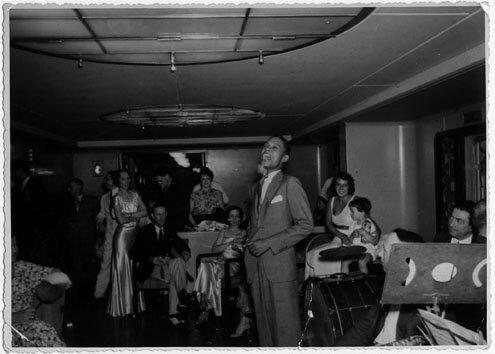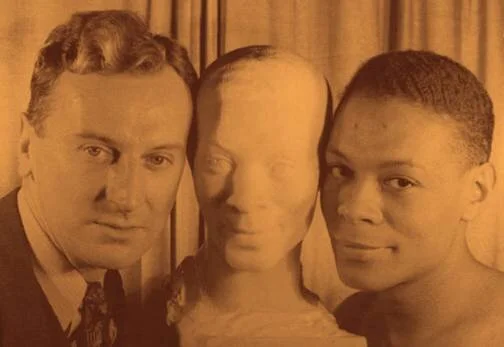The Origins of Fire Island’s Tea Dance at The Blue Whale
The Tea Dance as it was then called was created in the Pines by then owner John Whyte at the Blue Whale bar in 1966.
John Whyte
Upon purchasing the Pines Yacht Club from then owner Peggy Fears with partners in the early 60’s model John Whyte bought out all partners in 1964. He renamed it Pines and Dune Yacht Club with the Blue Whale bar.
He then created the Blue Whale drink. The drink made with Gin and Blue Curacao becomes a trademark, and makes the Pines the largest purchaser in the world of Blue Curacao. The Blue Whale becomes the hub of the Pines as many gather at happy hour to meet and greet. He hires popular African American entertainer Jimmie Daniels to provide musical back round.
Jimmie Daniels was born in Laredo, Texas in 1908, but was raised in Little Rock, Arkansas. He left Arkansas and traveled to New York in the 1920s, at the height of the Harlem Renaissance. He matriculated at Bird’s Business College in the Bronx where he studied business. He returned to Arkansas after completing school to become an administrative assistant for A.E. Bush, the president of Century Life Insurance Company. The monotony of office work and his wish to pursue a career as an entertainer caused him to leave his position. He traveled back to New York where he secured his first professional singing job at the Hot Cha nightclub in Harlem. He soon expanded his performing repertoire to include audiences in Europe. He spent 1933 and 1934 performing at the Summer Sporting Club in Monte Carlo, Monaco and at Ciro’s restaurant in London. After singing throughout Europe in the 1930s, he returned to New York where he became the proprietor of his own club in 1939. It was called the Jimmie Daniels’ Nightclub and he operated the business until 1942 when he entered the military.
During the period that Daniels ran his nightclub, he became a muse for renowned African American artist Richmond Barthe. In 1938, Kenneth MacPherson commissioned Barthe to create a marble bust of Daniels’ head. A photograph of Daniels standing next to the sculpture was taken by Carl Van Vechten, a prominent artistic photographer, and can be found within the collection. Photographs of these two artworks can also be found within the Daniels collection. Daniels’ involvement with the talented Barthe´ and the wealthy MacPherson was indicative of the relationships he formed with elite New Yorkers and these associations would serve him well in his next position.
A fresh-faced teenager, Jimmie Daniels arrived in Harlem sometime during the mid-1920’s. He was lithe, delicate, and had an engaging, infectious smile that he would soon learn to use to his advantage. Singer Alberta Hunter, a lifelong friend, remembered the time well. “This one was just a little one” she said. “Handsome? Oh, was he handsome! He had hair as red as fire, and his folks had money.” Dare anyone have said that they thought the young, refined singer with the impeccable style, grace and proper enunciation was just a little snobbish and pretentious too?
From 1939-1942, the ambitious Daniels owned his own supper club in Harlem. It would be the first of many. He could not always go downtown and be black and fabulous but he did learn how to bring downtown uptown and cash in during the process. Jimmie’s clubs catered to the downtown trade out for a night of slumming while searching for the exotique in Harlem. Everybody got what they wanted!
Charismatic Jimmie had a variety of lovers including Kenneth Macpherson, Richmond Barthe, who supported him and his adventures. By October of 1942, Jimmie was training in bootcamp during WWII. That must have been extremely interesting but true to form, he ended up entertaining the troops throughout Europe. He continued to host and perform throughout the 50’s, and intermittently for the rest of his life.
Jimmie Daniels History:
Chef Ernesto Tenente
By the early 60’s Jimmie found his way to Cherry Grove making friends along the way like chef Ernesto Tenente. Like many Ernesto would eventually find his way to the Pines as chef first at the Sandpiper and then the Blue Whale. Upon hearing about this owner John Whyte hired him.
There he would sing songs like “Pretty eyed Pussycat.” With the advent of the Jukebox, and the swinging 60’s the Pines community like the world was changing. Soul music was the scene and patrons at the Blue Whale were digging the scene. Soon they wanted more dancing and less Jimmie. Owner John Whyte soon found that the jukebox was more popular. Jimmie and Whyte decided to part ways leaving the dance floor at the Blue Whale to the Wurlitzer Juke Box.
Filled with the soul music of the 60’s the beat was all about the dance. The Tea Dance was born. However the growing gay population of the Pines were not allowed to dance together by law. The only way it could happen was in a group. The line dance was born. Dances like the “Hully Gully” and “The Madison” allowed men to dance together as long as there was at least one woman involved. It became the rage in the Pines. The dancing was monitored sometimes by owner John Whyte. Up on a ladder with a flashlight and megaphone to observe, if the men got too close the light would be shined on them. The dance would be featured in the 1970 film “Boys in the Band.” In 1967 Tea Dance went to 7 days a week during season.
Raids
by the Suffolk Police Department were a common occurrence. The men of the Pines were often rounded up like cattle and chained to poles in order for them to get their quota. Their identities were sometimes revealed in the local press. Owner John Whyte and longtime resident Jack Lichtenstein would help in bailing out of many.
By the 1970’s Disco music arrived and again the Tea Dance would evolve. It would now grow into a phenomenon that all of Fire Island would find their way to. With the creation of the longer playing 12″ Disco single record one song could be mixed into each other allowing for non interrupted dancing. The golden age of the Pines had arrived in the 70’s, and like the ever growing crowd of celebrity, designers, and artists the Tea Dance took on a glamorous persona making it the place to see and be seen.
The Yacht the “Barbara” owned by the Ross family of the Bicycle company was a fixture in front of the Blue Whale throughout the 70’s and 80’s. Barbara Ross herself would reign over the Tea Dance from the boat where dinner was ordered nightly and delivered from the restaurant.
The famous Blue Whale that hung over the bar and sign that noted the date Tea Dance began.
Throughout the 1980’s the legend of Tea Dance grew.
1987
In the late 80’s more and more people were hearing about the Tea Dance. The gay vs heterosexual scale was changing. Rowdy behavior was becoming common as it was becoming a place to see the gays instead of be with the gays.
The new club the Pavilion had an upper deck overlooking the harbor that was beginning to draw the local gay crowd. Manager / Realtor Bob Howard would create what would be called High Tea as this caught on.
The Tea Dance would recover as owner John Whyte would eventually purchase his competition the Pavilion in 1989. The colors would change. All would live together as the Tea Dance tradition grew.
NYC
John Whyte would expand on the Blue Whale image by opening a sister restaurant/club in New York City…
It would evolve again as the properties are sold first to Eric Von Kuersteiner in 2004, and then to businessmen Andrew Kirtzman, Seth Weissman, and Matt Blesso. The Tea Dance would go slang as not to be confused with High Tea. It would now be Low Tea per its destination.
One thing never changes when the sun goes down its time for Tea Dance in the Pines. In 2006 an ongoing party called Party at the Pavilion with DJ Vito Fun evolved into what would now be called Middle Tea.
The Tea Dance has been written up in various forms here is one:
The History of Tea Dance by Will Kohler.
The Very Gay History of the Almost Lost Tradition of the Sunday Tea Dance
Many gay men under the age of 30 are totally clueless of almost lost tradition of the Sunday Tea Dance. (A tradition that really must be brought back.) So here’s a little history primer on the tradition of the “Sunday T-dance” and how and why we embraced it in the LGBT culture.
Historically, tea was served in the afternoon, either with snacks (“low tea”) or with a full meal (“high tea” or “meat tea”). High Tea eventually moved earlier in the day, sometimes replacing the midday “luncheon” and settled around 11 o’clock, becoming the forerunner of what we know as “brunch”.
From the late 1800s to well into the pre-WWI era in both America and England, late afternoon (low) tea service became the highlight of society life. As dance crazes swept both countries, tea dances became increasingly popular as places where single women and their gentlemen friends could meet — the singles scene of the age.
While tea dances enjoyed a revival in America after the Great War, The Great Depression of the 30s wiped them out. Tea consumption was in steady decline in America anyways and by the 50s, tea was largely thought of as something “your grandmother drinks”. Also, nightlife was moving later and younger. Working men and women were too busy building the American Dream to socialize so it was left to their teenaged children in the age of sockhops and the jukebox diner. Rock and roll was dark and dangerous — something you sneaked out for after dinner, not took part in before dinner.
Gay people, of course, were still largely underground in the 50s, but it was in these discreet speakeasies that social (nonpartnered) dancing was evolving. It was illegal for men to dance with men, or for women to dance with women. In the event of a raid, gay men and lesbian women would quickly change partners to mixed-couples. Eventually, this led to everyone sort of dancing on their own.
By the late 60s, gay men had established the Fire Island Cherry Grove and also the more subdued and “closeted” Pines (off of Long Island, in New York) as a summer resort of sorts. It was illegal at that time for bars to ‘knowingly sell alcohol to homosexuals’ and besides many of the venues there were not licensed as ‘night clubs’ or to sell alcohol. To avoid attracting attention, afternoon tea dances were promoted. Holding them in the afternoon also allowed those who needed to catch the last ferry back to the mainland to attend.
The proscription against same-sex dancing was still in effect, so organizers were forced to institute ‘no touching’ rules. Since there were no lesbians around to change partners with, gay men developed the “dancing apart” style that clubgoers everywhere now take for granted.
June 28, 1969…the Stonewall Riots mark the fiery birth of the so-called “modern gay rights movement”. Following (and in part perhaps inspired by) the death of gay icon Judy Garland, (as the urban legend goes) patrons of the Greenwich Village watering hole The Stonewall Inn fought back against another in a very long line of violent police raids, eventually barricading the police inside the bar and setting off three nights of rioting. The “snapped stiletto heel heard around the world”as some call it is commemorated today with Gay Pride celebrations held around the end of June.
Post-Stonewall, the tea dance moved from the Fire Island Pines to Greenwich Village. A newly-energized gay community around Christopher Street embraced the social dancing craze started on Fire Island. While the Fire Island gays tended to be rich upper-class preppies, the downtown gays of Christopher Street and the Village were working-class and they tended to party at night. As in the straight community, tea dances gradually moved later until they became subsumed into the night club scene.
Through the 70s, gay men championed the uniform of the working class — t-shirts and denim — as fashion aesthetic. In part because they were affordable, and in part because it projected an appealing hypermasculinity associated with the working class. Gays in the post-Stonewall era were consciously rebelling against the effete stereotypes associated with the manicured, sweater-wearing, tea-drinking gays of the Fire Island set. Real men wore t-shirts and drank beer. Gay men still had afternoon/early evening dances — usually on Sundays, in order to make the most of one’s weekend while still being able to get up for Monday morning’s work.
The downtown gays rejected the term tea dance as being too effete and opted for the supposedly butcher t-dance, and promoted “t-shirts and denim” as the costume of choice. By the mid 70s, the “Christopher Street Clone” look (short cropped hair, mustache, plaid shirt over a tight white t-shirt, faded denim jeans that showed off your ass) had made the trans-continental trip from New York City to Los Angeles (gays in Hollywood) and, of course, to San Francisco (follow the Yellow Brick Road and it leads to Castro). It brought with it the tea dance phenomenon, which is slowly dying out and is nothing of its former self and in may places is all but gone.
Will Kohler is a noted LGBT historian, writer, blogger and owner of Back2Stonewall.com. A longtime gay activist, Will fought on the front lines of the AIDS epidemic with ACT-UP and continues fighting today for LGBT acceptance and full equality. Will’s work has been referenced in notable media venues as MSNBC and BBC News, The Washington Post, The Advocate, The Daily Beast, Hollywood Reporter, Raw Story, and The Huffington Post
Today the Tea Dance is a tradition replicated all over the world. It continues in its birthplace daily in season. The brand has expanded to include more Tea’s, however its history shall remain in the Blue Whale where it began…
2022























































